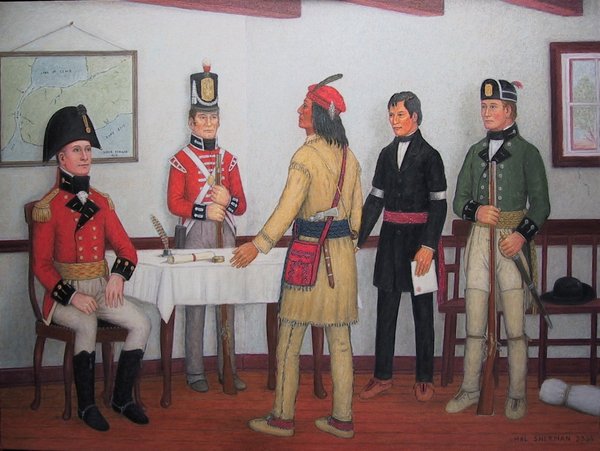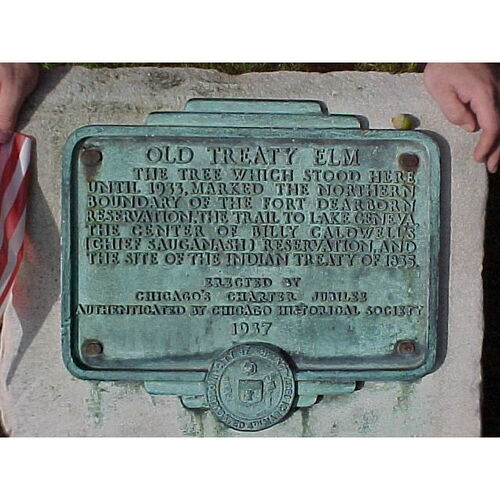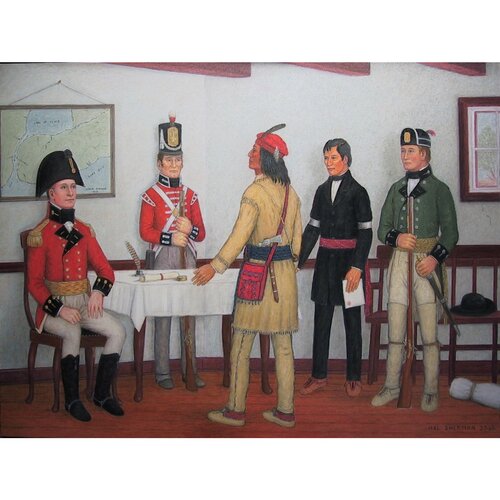
Source: Link
CALDWELL, BILLY (possibly baptized Thomas, sometimes called Sagaunash), Indian Department official and merchant; b. 17 March, c. 1780, in the vicinity of Fort Niagara (near Youngstown, N.Y.); d. 27 Sept. 1841 at Trader’s Point (near Council Bluffs, Iowa).
Billy Caldwell was one of the frontier personalities who were born out of passing liaisons between British men and native women and who spent their lives on the social boundary between British or American and Indian institutions. The natural son of William Caldwell*, a captain in Butler’s Rangers, and a Mohawk woman whose name is unknown (she was a daughter of Rising Sun), Billy Caldwell was abandoned by his father while an infant. Ordered west to Detroit, the elder Caldwell left Billy to spend his childhood among the Mohawks near Niagara and later on the Grand River (Ont.). About 1789 he brought the boy into the family created by his marriage to Suzanne Baby at Detroit. There Billy Caldwell received a basic education aimed at making him into a family retainer, the manager of the Caldwell farm on the south side of the Detroit River. He rejected the status of second-class son, however, and crossed into American territory to enter the fur trade.
Caldwell began his 37-year association with the Thomas Forsyth–John Kinzie trading partnership in 1797, first in what is now southwestern Michigan and along the Wabash River, later in the northern part of present-day Illinois, where in 1803 he rose to the position of chief clerk in the firm’s new post at Chicago. A Potawatomi woman named La Nanette, of the powerful fish clan, was his first wife; she died shortly after the marriage, whereupon he married a daughter of Robert Forsyth and an Ojibwa woman. After his second wife’s death he again married, this time a person known only as the Frenchwoman, likely the daughter of an influential Métis trader in Chicago. He had some eight to ten children in all, none of whom lived to adulthood or survived him.
Until 1820 Caldwell identified himself as a “true Briton,” remaining faithful to the values he had acquired in the Detroit River border communities where he was raised, in spite of the fact that his father never recognized him as his rightful eldest son. By early 1812 he was reputed to be especially influential among the powerful Potawatomi, Ottawa, and Ojibwa communities around Lake Michigan, so that both American and British officials vied for his services in the coming war. Spurning overtures from Governor William Henry Harrison of Ohio, during the winter of 1812–13 he made his way back to Amherstburg, Upper Canada, and there he obtained a commission as captain in the Indian Department. His first combat experience came at the River Raisin (Mich.) in January 1813, where he was severely wounded while attempting to rescue an injured American officer. He later served as a liaison officer with Indian forces at the sieges of Fort Meigs (near Perrysburg, Ohio) and Fort Stephenson (Fremont, Ohio), at the battle of Moraviantown, and on the Niagara frontier.
Upon the death of Matthew Elliott* in 1814, efforts were made to have Caldwell replace Elliott as superintendent of Indians for the Western District, but his father was appointed with Billy as second-in-command. Subsequently Billy collaborated with Lieutenant-Colonel Reginald James, commanding the garrison at Fort Malden (Amherstburg), in successful attempts to depose his father, and thus secured the post of superintendent. However, he proved inept in his administrative duties and was discharged from the Indian Department in September 1816. Thereafter he tried ineffectually to establish himself as a merchant in Amherstburg and vicinity. By 1820 he had left Upper Canada forever. Having immigrated to the Chicago area he worked in the Indian trade and soon became an American citizen.
It was in Chicago between 1827 and 1833 that various legends grew up concerning Caldwell’s ancestry, rank, and status, which eventually made him a “half-breed principal chief” of the Potawatomis. None of the details of these fictions – that he was a Potawatomi, a chief, the saviour of the whites who survived the battle near Fort Dearborn (Chicago) in 1812 – is historically documented. They represent the fabrications of his employers, who had him appointed as an American-recognized chief the better to serve their business interests. Some legendary elements, for example the fable that he was Tecumseh*’s private secretary, represented his own embellishments. Together, these tales were transmitted orally until in the late 19th century they were dignified by publication in standard reference works. His supposed Potawatomi name, Sagaunash, as it turns out, was not a personal name at all but an ethnic label, sakonosh, by which these tribesmen identified him as “the English-speaking Canadian.”
Caldwell was influential in aiding the negotiation of the final series of treaties signed by the United Bands of Potawatomis, Ottawas, and Ojibwas of Wisconsin and Illinois, which ended in 1833 when they ceded their last block of lands at the Treaty of Chicago. His services no longer needed, he was then abandoned by his American patrons and thereafter entered the full-time employ of the united bands. He migrated with them to western Missouri and Iowa where he made his final home, managing their business affairs and negotiating on their behalf with American officials until his death of cholera in 1841.
An exhaustive bibliography of the primary sources relating to Billy Caldwell and of the various printed traditional sketches of him can be found in two works by the author, “Merchant, soldier, broker, chief; a corrected obituary of Billy Caldwell,” Ill. State Hist. Soc., Journal (Springfield), 71 (1978): 185–210, and “Personal and ethnic identity on the Great Lakes frontier: the case of Billy Caldwell, Anglo-Canadian,” Ethno history (Tucson, Ariz.), 25 (1978): 69–94.
Among the important manuscript sources are BL, Add. mss 21885: 121 (copy at PAC); Chicago Hist. Soc., Billy Caldwell to Francis Caldwell, 17 March 1834; and Wis., State Hist. Soc., Draper mss, 175229–35, 238–40; 21574–88. Most of the extensive correspondence from, to, and about Caldwell during his Indian Department years is found in PAC, RG 10, Al, 4, and A2, 28, 30–34; further information from these years and also concerning the 1816–19 period is in the Caldwell papers, PAC, MG 24, B 147 (photocopies).
Cite This Article
James A. Clifton, “CALDWELL, BILLY (possibly baptized Thomas) (Sagaunash),” in Dictionary of Canadian Biography, vol. 7, University of Toronto/Université Laval, 2003–, accessed December 12, 2025, https://www.biographi.ca/en/bio/caldwell_billy_7E.html.
The citation above shows the format for footnotes and endnotes according to the Chicago manual of style (16th edition). Information to be used in other citation formats:
| Permalink: | https://www.biographi.ca/en/bio/caldwell_billy_7E.html |
| Author of Article: | James A. Clifton |
| Title of Article: | CALDWELL, BILLY (possibly baptized Thomas) (Sagaunash) |
| Publication Name: | Dictionary of Canadian Biography, vol. 7 |
| Publisher: | University of Toronto/Université Laval |
| Year of publication: | 1988 |
| Year of revision: | 1988 |
| Access Date: | December 12, 2025 |




